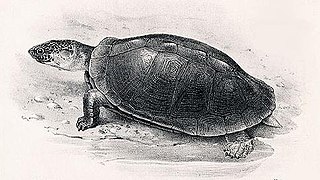
The spiny turtle is a South-East Asian turtle species. It inhabits lowland and hill rainforest, usually in the vicinity of small streams, mainly in hill areas up to 900 m above sea level.

Pelochelys is a genus of giant softshell turtles in the family Trionychidae.

The narrow-bridged musk turtle is a species in of turtle in the family Kinosternidae. The species is endemic to Central America and Mexico.

Cycloderma is a genus of softshell turtles in the family Trionychidae. The genus is endemic to Africa.
Dahl's toad-headed turtle is a medium-sized species of side-necked turle in the Chelidae family. This critically endangered freshwater turtle is endemic to small pools, streams, and swamps in northern Colombia, but it aestivates on land.

Hoge's sideneck turtle is a species of turtle in the family Chelidae. The species is found in the eastern Atlantic Forests of Brazil, primarily in the Carangola River of Minas Gerais and Paraíba do Sul River, Rio de Janeiro. The most documented population resides in the midsection of the Carangola River with an estimated population of less than 2000.

The red side-necked turtle, red turtle, red-footed sideneck turtle, William's toadhead turtle, or red-footed Amazon side-necked turtle is a monotypic species of turtle in the family Chelidae. It is found in Colombia and possibly Peru and Brazil.

Vanderhaege's toad-headed turtle is a species of turtle in the family Chelidae. The species is endemic to South America.
The Zulia toad-headed sideneck, also known commonly as the Zulia toad-headed turtle, is a species of turtle in the family Chelidae. The species is endemic to Venezuela.

Mesoclemmys is a South American genus of turtle in the Chelidae family.

The painted wood turtle or spot-legged wood turtle is a species of turtle belonging to the genus Rhinoclemmys of the family Geoemydidae.

Mesoclemmys gibba, known as the toadhead turtle or gibba turtle, is a small side necked turtle found in a wide area of South America, in Peru, Ecuador, Colombia, Venezuela, Trinidad, Guyana, Surinam, Paraguay, and parts of Brazil.
The African keeled mud turtle is a species of turtle in the family Pelomedusidae. It is endemic to central Africa : the Democratic Republic of the Congo, the Republic of the Congo, and Gabon.
The Ivory Coast mud turtle is a species of turtle in the family Pelomedusidae. It is one of the most recently described turtle species. It is found in Sierra Leone, Liberia, Côte d'Ivoire, Ghana, Togo and Benin.

The African forest turtle is a species of turtle in the family Pelomedusidae. It is endemic to Africa, where it can be found in Angola, Burundi, Cameroon, Equatorial Guinea, Gabon, the Democratic Republic of the Congo, the Republic of the Congo, Ghana, Tanzania, and Uganda
The African dwarf mud turtle is a species of turtle in the family Pelomedusidae. It is endemic to Africa : in Angola, the Democratic Republic of the Congo, Malawi, and Zambia.

The West African black turtle is a species of turtle in the family Pelomedusidae. It is endemic to Africa, in Cameroon, Equatorial Guinea, Gabon, and Nigeria.
Mesoclemmys heliostemma is a species of turtle. They are endemic to South America, with reports in Venezuela, Ecuador, Peru and Brazil. The type locality of the species is the base of Pico da Neblina, on the Brazilian-Venezuelan border.
Mesoclemmys nasuta is a species of turtles that lives in Bolivia, Colombia, Peru, Brazil and the Guyanas.
Mesoclemmys raniceps is a side-necked turtle found in the Amazon basin and Orinoco basin. Little is known about the turtle's life cycle, but there is evidence that the females can lay a clutch of 4-8 eggs several times in the year. Males are usually smaller than females in length. Males can be distinguished from females by the prominent white scales they have on the external border of their skin which cover the tibia. Mesoclemmys raniceps can be identified by the black stripe on each side of their head which extends from the snout through the eyes and ends at the exterior end, the tympani.










